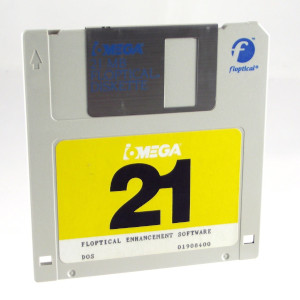
|
This site is running on a 286 PC, booted and served
entirely from a 90mm floppy disk. See current
server stats. All content on this site is provided by the Museum of Obsolete Media, curated by Jason Curtis. My sincerest thanks to Jason for providing me with the worthy challenge of exhibiting his work in the only appropriate way: The Floppy Disk Museum: The Bootable Floppy edition! |


Floptical was a brand of drive introduced in 1991 by Insite Peripherals, and was also the name of the technology which was a type of floppy disk combining magnetic and optical systems. Floptical disks were the same size as the standard 3.5-inch microfloppy disk and Floptical drives could read these using a second set of read/write heads.
Data is written to the disk magnetically, while optically aligning the read/write head in the drive using grooves in the disc being sensed by an infra-red LED. The optical servo tracks allowed for an increase in the tracking precision of the magnetic head, from the usual 135 tracks per inch to 1,250 tracks per inch, allowing 21 MB of storage.
Insite licensed the floptical technology to a number of companies and a number of these formed the Floptical Technology Association, or FTA, to try to have the format adopted as a floppy replacement.
Around 70,000 Floptical drive are believed to have been sold worldwide in the product's lifetime, although it had lingering quality and reliability issues, and was generally much slower than other technologies such as the Iomega Zip. Iomega had licensed the Floptical technology, but dropped it in favour of their own Zip drive.
Later non-compatible floptical systems included SuperDisk and HiFD.
Dimensions: 94 mm * 90 mm * 3.3 mm
Capacity: 21 MB